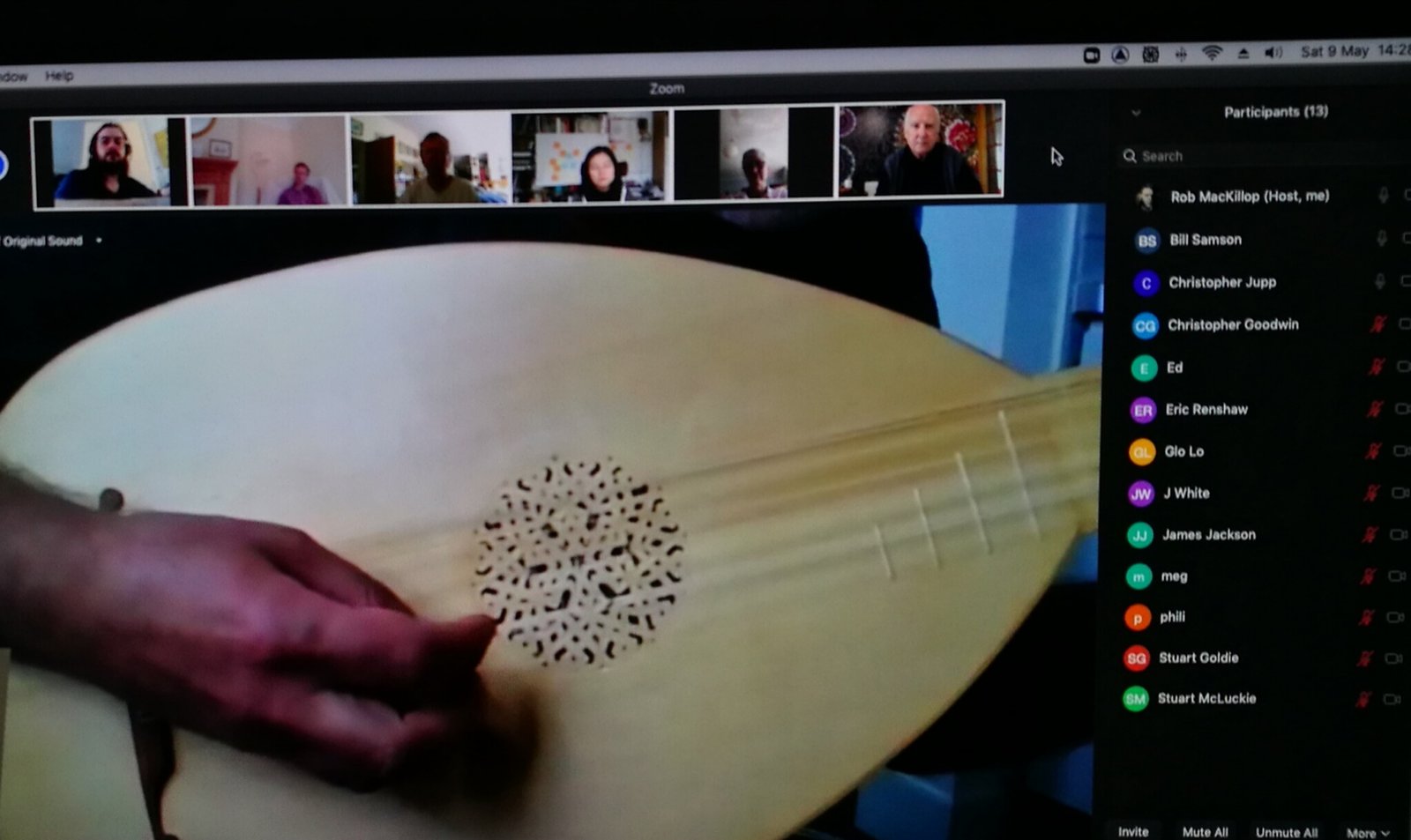Report of a Zoom Meeting 9th May 2020
Well, this was a change from our usual meetings! Thanks to Covid-19, we thought it might be interesting to hold a Zoom conference-style meeting. Did it work? Well, not quite as hoped, but probably as expected.
Thirteen people tuned in, with five people offering to play. Before I get into who played what, there are a few comments I’d like to make to potentially improve matters should we do another Zoom meeting in the future.
Sound: It’s a complex issue. Having a USB microphone helps considerably, as long as you make some audio choices in the Zoom platform. Even if you don’t use an external microphone, you can still improve the quality of sound for music, as outlined in this video:
Visuals: The next thing to consider is how you present yourself when performing, and The Lute Society has a very helpful video from someone who really knows what he is talking about, though he is really talking about making a video presentation, but the points he makes are pertinent to Zoom:
As for observers, by far the best thing you can do to improve the sound you are hearing is to use headphones. Even a cheap pair will dramatically improve the sound you are hearing, but generally speaking the more you pay the better the sound.
So, to the meeting itself!
Rob Mackillop was MC, and started with an apology for not actually playing an historically-relevant instrument. He has lately become obsessed with 5ths tuning, such as found on violins and cellos, and is doing research into what historical instrument might best suit him. A brief foray into cello playing was discouraging: the bow had a mind of its own, and the left hand required far more pressure than his hand was used to or could cope with! So his mind started wandering towards the 18th-century mandolin, the type made by Antonio Vinaccia, with a gut first string, and thin harpsichord wire for the remaining courses, with the 4th course being in octaves. Such a setup would be quite different from the more modern high-tension instruments. However, there are very few luthiers making historically accurate instruments, and those who do tend to copy the most ornate instruments, for which they naturally charge premium prices.
And then Rob “discovered” the Brescian or Cremonese mandolin, which had four single gut strings. This is definitely something Rob was interested in, but to make sure he really wanted to play the repertoire for it he tuned his ukulele in 5ths, CGDA, which is how he came to be performing a ukulele at a SLEGS meeting!
Rob’s ego told him he was the inventor of the Ukelin or Mandolele (!) but soon discovered that it is a known thing, and of course – we should have known – the string company Aquila-Corde already sell 5ths-tuning sets for ukuleles. Just think of the extent of the repertoire that uses 5ths tuning: all the Bach cello suites and violin Partitas and Sonatas, not to mention pretty much everything ever written for these instruments! And then there is the mandolin: a good-sized mountain of music is there to be plundered.
Rob chose to play “De la Reine de la Golconde“, a theme with two variations, from Pietro Denis‘ Method for mandolin, Paris, 1768. The beautiful theme is often over-romanticised by using higher positions on lower strings (Segovia’s editions of Bach come to mind), yet the original notation seems to imply otherwise. The theme is no less beautiful for playing in first position, and the mellowness of the ukulele made a good argument for doing so. The two variations explored mandolin plectrum techniques before a return of the opening theme.
We shall wait and see where Rob ends up in his exploration of 5ths tuning.
Next up was Bill Samson, playing his own-made classical guitar, but not before showing us a three-quarters-finished copy of a Lacote guitar, which he will hopefully play for us at the next meeting. Bill played a beautiful study by Carcassi, number 1 from volume 3 of his Opus 59 guitar method, and his interpretation caught the spirit of it perfectly. It would be good to hear it again on his Lacote, and hopefully with the audio recording quality settled.
Philip Lord played his Michael Lowe 13c lute the following three items: Prelude from Stockholm Kungliga Biblioteek S176, a Sarabande from the same source, and Preliminaire from Kalmar 21068 (Another Swedish manuscript). Despite sound issues, this was the most assured performance we have heard from Philip on the 13c, so keep it up, sir!
Two latecomers appeared after having been waiting in a Google room. Not their fault. When Zoom sent out the invitation it included a link to go there, why I don’t know. They missed the entirety of the preceding performances. But, better late than never…
Chris Jupp gave a wonderful rendition of Francesco da Milano’s Fantasia, Ness 38. This is not an easy piece to physically execute, but even harder to make a musical statement with. Chris managed both with aplomb, and it is wonderful to see his performances improving with every meeting. Find a singer, Chris, and let’s hear some lute-song repertoire.
Stuart McLuckie played two pieces from the Lute Society’s 70 Easy to Intermediate pieces for Renaissance lute: number 29 Balletto and number 32, the Balletto de Florenza. Stuart also played well, tasteful and with a good rhythm. It was a good way to end proceedings.
I only had the presence of mind to take one screen shot, this of Chris Jupp, the one handed lute player (let’s see both hands next time, Chris!)

To sum up, a partial success, partial failure. Once we all get our sound and posing sorted, it might be worthwhile doing another such meeting.
Leave a Reply